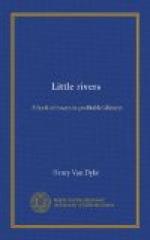All the waggons in the place were engaged. It is strange what an aggravating effect this state of affairs has upon a pedestrian who is bent upon riding. I did not recover my delight in the scenery until I had walked about five miles farther, and sat down on the grass, beside a beautiful spring, to eat my lunch.
What is there in a little physical rest that has such magic to restore the sense of pleasure? A few moments ago nothing pleased you—the bloom was gone from the peach; but now it has come back again—you wonder and admire. Thus cheerful and contented I trudged up the right arm of the valley to the Baths of Neu-Prags, less venerable, but apparently more popular than Alt-Prags, and on beyond them, through the woods, to the superb Pragser-Wildsee, a lake whose still waters, now blue as sapphire under the clear sky, and now green as emerald under gray clouds, sleep encircled by mighty precipices. Could anything be a greater contrast with Venice? There the canals alive with gondolas, and the open harbour bright with many-coloured sails; here, the hidden lake, silent and lifeless, save when
“A
leaping fish
Sends through the tarn
a lonely cheer.”
Tired, and a little foot-sore, after nine hours’ walking, I came into the big railway hotel at Toblach that night. There I met my friends again, and parted from them and the Dolomites the next day, with regret. For they were “stepping westward;” but in order to get to the Gross-Venediger I must make a detour to the east, through the Pusterthal, and come up through the valley of the Isel to the great chain of mountains called the Hohe Tauern.
At the junction of the Isel and the Drau lies the quaint little city of Lienz, with its two castles—the square, double-towered one in the town, now transformed into the offices of the municipality, and the huge mediaeval one on a hill outside, now used as a damp restaurant and dismal beer-cellar. I lingered at Lienz for a couple of days, in the ancient hostelry of the Post. The hallways were vaulted like a cloister, the walls were three feet thick, the kitchen was in the middle of the house on the second floor, so that I looked into it every time I came from my room, and ordered dinner direct from the cook. But, so far from being displeased with these peculiarities, I rather liked the flavour of them; and then, in addition, the landlady’s daughter, who was managing the house, was a person of most engaging manners, and there was trout and grayling fishing in a stream near by, and the neighbouring church of Dolsach contained the beautiful picture of the Holy Family, which Franz Defregger painted for his native village.
The peasant women of Lienz have one very striking feature in their dress—a black felt hat with a broad, stiff brim and a high crown, smaller at the top than at the base. It looks a little like the traditional head-gear of the Pilgrim Fathers, exaggerated. There is a solemnity about it which is fatal to feminine beauty.




